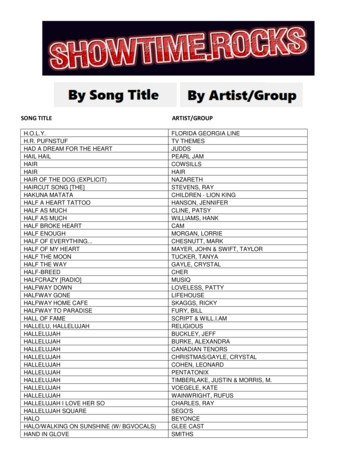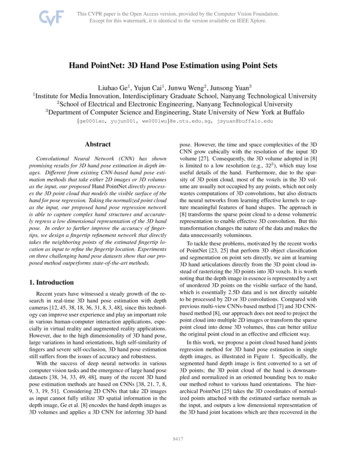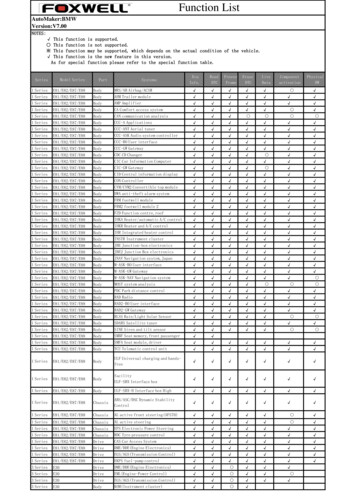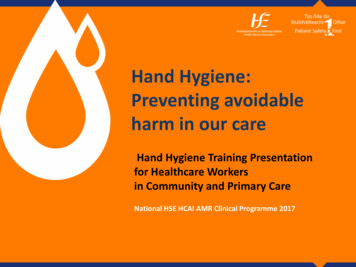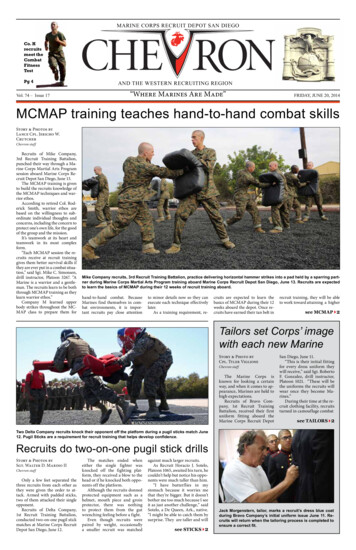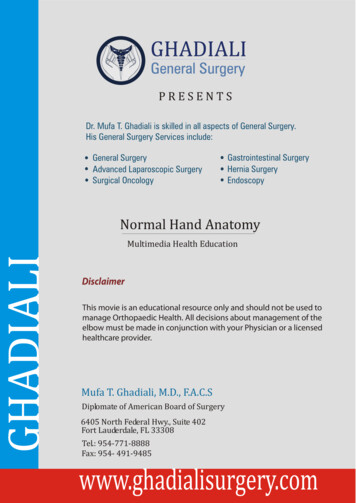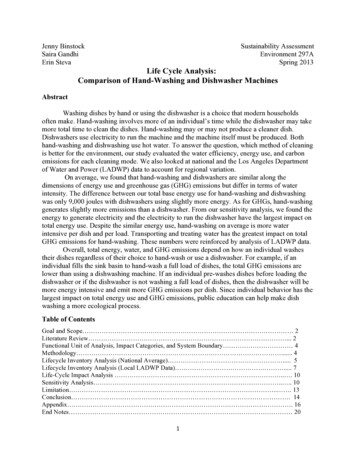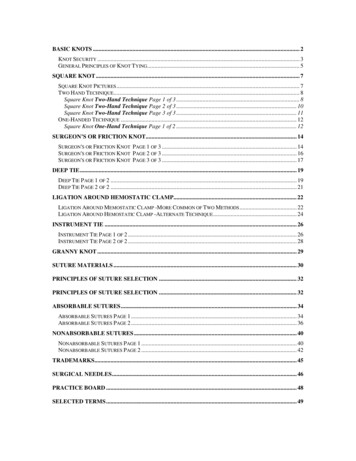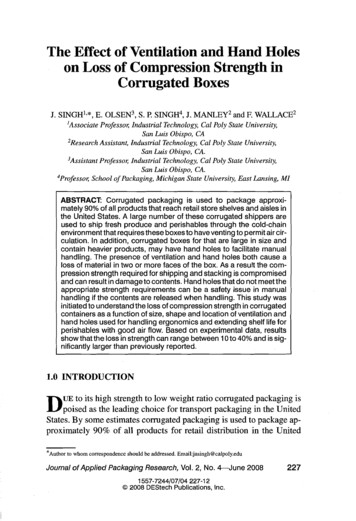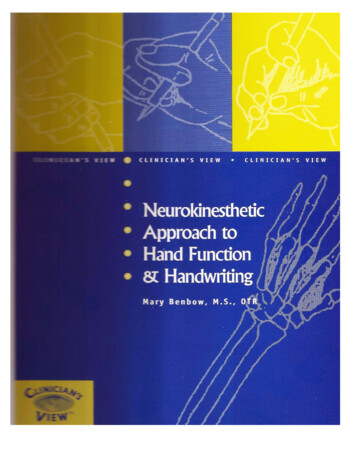
Transcription
NEUROKINESTHETIC APPROACH TO HANDFUNCTION AND HANDWRITINGPresented byMary Benbow, M.S., OTR
Understanding the Hand from theInside-OutDevelopmental ActivitiesBased on Hand AnatomyMary Benbow, MS, OTR
RELEVANT ANATOMYNormal use and function of the hand are dependent upon the synergy of many muscles; thoseacting on the wrist, as well as the digits. The muscles of the wrist are important because theystabilize and prevent unwanted wrist movements, which allow the finger muscles to maintain anadequate length that is favorable for producing tension and prehension. The muscles of the handand wrist are so closely linked that it is virtually impossible to voluntarily omit a muscle fromthe synergy of which it belongs. Understanding the anatomy of the hand and wrist is importantfor appreciation of the intricate and synergistic function of the muscles and joints, which work sointricately to provide functional grasp, release and skilled manipulation.WRIST EXTENSORS AND FLEXORSFinger movements should work in reciprocal synchrony with movements of the wrist. Grasp isweaker with wrist flexion than with wrist extension. Wrist extension is critical to stabilizing thestructure and allowing finger movements at the best mechanical advantage for freedom of rangeand control.Children with fine motor and writing problems often lack good wrist stability in extension andtherefore cannot activate the most functional finger movements required for skilledmanipulation.To maintain good stability of the wrist in extension for distal finger function, it is necessary forthe wrist flexors to work antagonistically with the wrist extensors to provide stable cocontraction and maintain the proper control of the wrist in its best functional position.EXTRINSIC MUSCLESThe extrinsic finger muscles have their bellies in the forearm. These muscles narrow to passthrough the carpal tunnel and into the tendon sheath. They insert on the IP joints of the digits.The extensor extrinsics are responsible for extending the MP joints of digits 2 through 5 andextend the wrist by continued action. The flexor extrinsics flex the PIP joints and the MP jointsand the wrist by continued action.MUSCLES OF THE PALMThe palmar aponeurosis is a fibrous tissue within the palm that is pulled by the palmaris longus,which gathers the fascia as a unit to arch the palm. The brevis draws the skin over the hypothenareminence to the middle of the palm and also assists in palmar arching.Intrinsic muscles of the palm function primarily to move the fingers in abduction or adduction inrelation to the midline axis of the hand. The palmar interossei, dorsal interossei and lumbricalsfunction to provide delicate coordination of the digits in abduction, adduction, flexion of the MPjoints while extending the PIP joints, shape the fingers to fit objects, control tension between thefinger flexors and control precise balance between the thumb and index fingers.
INTRINSICS OF THE FIFTH DIGITThe little finger and the thumb have a special relationship and add to the grasp and balance of thehand. The flexor digiti minimi, abductor digiti minimi and opponens pollicis & digiti minimi arereferred to as the hypothenar muscles. They work in synergy to flex the MP joint of the 5th digit,abduct the fifth digit and rotate the fifth MC joint at the CMC joint for opposition to the thumb.EXTRINSIC MUSCLES OF THE THUMBThe extrinsic muscles of the thumb all have their origin in the forearm. The extensor poillicisbrevis and longus extend the MP joint of the thumb and radial deviates the wrist. The abductorpollicis longus abducts the CMC joint, radially deviates the wrist and assists in slight flexion ofthe wrist. The flexor pollicis longus flexes the IP joint of the thumb and the MP and CMC jointsby continued action.INTRINSIC MUSCLES OF THE THUMBThe intrinsic muscles of the thumb are the abductor pollicis brevis, flexor pollicis brevis andopponens pollicis. These three muscles make up the skill triad and provide rotation of the thumbat the CMC necessary for active opposition, manipulation and delicate touch. The adductorpollicis is a power muscle and adds strength to opposition.HAND MOVEMENTSThe structure and function of the anatomy of the hand and wrist are responsible for an almostinfinite combination of skilled movements of the digits, supported by stability of the wrist andelbow, arches of the hand and the joints of the upper extremity. If one considers the intricatemovements of the hand and its skills, the many problems, which can arise in writing andmanipulation, can be appreciated.Children with dysfunctional hands show typical symptoms of a lack of neuromuscular maturity.The arches of the hand are often flat and incompletely developed. There is also a lack of motoricseparation between the radial and ulnar sides of the hand. The internal stability of the hand isoften in the low normal or low tone range. A related problem is in establishing good wriststability. The digits often lack controlled flexion/extension and rotation, which are critical formanipulation. Each child must be carefully assessed for the specific degree and area ofdysfunction, so that appropriate developmental hand activities can be used to prepare, strengthenand develop the components of functional hand, wrist and finger movements.
WRIST EXTENSORS AND FLEXORS
EXTRINSIC EXTENSORS OF DIGITS
JOINT POSTURES AS THEY RELATE TO POSITION OF LATERAL BANDS
POWER MUSCLES OF THE THUMB
SKILLED MUSCLES OF THE THUMB
ANATOMICAL BALANCING MECHANISMS FOR HAND FUNCTIONFOREARMThe radial INNERVATED supinator works in balance with the median innervated pronator teres.WRISTPrime stability at the wrist comes from the wrist extensor located diagonally opposite to the side of thehand, which is functioning. Therefore, when the radial digits (ii & iii) and thumb are manipulating, theextensor carpi ulnaris serves as the prime stabilizer. When the ulnar side of the hand is incorporated forpower, the extensor carpi radialis brevis is the prime stabilizer. Anatomical fixed and mobile structureswithin the hand allow it to rotate around its "midline."RADIAL DIGITSCarpometacarpal joints are essentially fixed to stabilize the palm in opposition and provide the proximalstability for the highly mobile MP joints of digits ii & iii.Metacarpal phalangeal joints are diarthrodial and they are very mobile to allow movement in three planes.ULNAR DIGITSCarpometacarpal joints are mobileDigit v range of motion is 25-30 of motion at the little finger articulation.Digit iv range of motion is 15 at the ring finger.Metacarpal phalangeal joints are diarthrodial joints. They are less mobile than the radial MP joints butallow limited movement in three planes.THUMB/FINGER STRENGTH BALANCEThumb: the intrinsics muscles are the stronger group.Fingers: the extrinsics muscles are significantly stronger.Finger strength: the longer the finger, the stronger the fingerWhole hand function: the peripheral digits i and v balance each other in total hand patterns.
INEFFICIENT GRIPS
EFFICIENT GRIPS
Altering an Inefficient GripIn development of motor skills, there is evidence of transfer between different forms of action.The precision grip once mastered and reliably used with a spoon begins to be used in drawingwith a pencil. Therefore the instructor or therapist should evaluate the child’s skills in use of aspoon or fork before attempting to alter the more complex skill with a writing tool. Silverwarerequires only stabilization with the skilled digits. A writing tool requires stabilization withmobilizing. If the child uses an immature power grip on a spoon, the instructor should developthis sub-skill before advancing to writing tools.Hand structures required for tool stabilization with distal manipulating are:a) Active metacarpal phalangeal arch with three degrees of freedom (flexion/extension,adduction/abduction, and rotation) at the metacarpal phalangeal joint of the index finger.b) Full range of motion at the carpal metacarpal joint of the thumb is required to stabilizethe open web space. Conditions a & b may require therapeutic intervention with specificdevelopmental activities to achieve the desired results.c) Joint stability; a most prevalent finding is ligament instability within the joints of thehands. Shifting the pencil into a more stable web space between the index and ringfingers is often a convenient intervention. In severe cases the use of a neoprene splint, asan outside stabilizer may be required.Before intervening with a student with an inefficient grip, it is critical for him to understand whyit is worth his effort to change it. Pencil grips that are not held within the pulps of the digits donot lead to economy, variety and convenience for proximal-distal axis in the simple flexor orextensor synergy to produce fast enough writing needed once the output demands increase aboutthird grade.An adducted grip (which diminishes the proprioceptive input from the lumbricales from theskilled digits) does not allow the luxury of the unconscious regulation of the gripping pressure onthe shaft of the pencil or the downward pressure of the pencil point against the writing surface.This is the reason many students frequently need to stop, release their grip on the pencil andshake the pain out of the fingers. He should be made aware that power grips might result inpainful joint dysfunctions later in life due to the stress they cause to the support structures of thejoints.The following sequence can make the transition to the functional grip less stressful and moresuccessful.1.The instructor demonstrates how to position a pencil between index and long finger to makelarge random patterns on the paper using only shoulder and elbow movements.2. The child imitates the instructor by positioning the between the same two digits to make largefree flowing movements (no finger movements, letter or number symbols are allowed).3. After the child adjusts to the feel of the pencil in the index/middle finger web space, sheshould be encouraged to draw anything she pleases.
DEVELOPMENTAL HAND PROGRAMThe developmental hand program consists of over 65 activities designed to improve handfunction, dexterity and control. The activities are divided into 9 sections, including proximalcontrol of the shoulders, the elbow and the wrist, distal finger movements, precision translation,precision rotation, motoric separation of the two sides of the hand, thumb activities and jointstability within the hand. Activities are easily chosen based on the observation of hand skillsassessment previously described. Each of these activities is clearly explained and demonstratedin the video "Developmental Hand Program," by Mary Benbow, and available from Clinician'sView .The human hand is dependent on multiple factors for sensibility of adjustment, economy ofexecution and accuracy of skill. This hand program has been developed to guide professionals insystematic assessment and inclusive activities to enhance the varied components of fine motorskills of children.OVERALL DEVELOPMENTDevelopmental therapists, trained to look at the whole body and its interrelationships, mustaddress ergonomic factors (postural, tonal, and stabilizing) for fine motor intervention to be mosteffective. Fine motor difficulties listed in this handout will focus on incomplete utilization of theproximal joints of the upper extremity, immature hand development and lack of joint stability.Commonly related developmental issues such as bilateral integration and visual-motor incoordination will not be addressed in this handout.PROXIMAL JOINT CONTROLThe development of dexterous hand skills depends on the interaction of all joints of the upperextremity: scapulothoracic, glenohumeral, elbow and wrist. Every joint must move freely into itsmature pattern (s). Therefore, each joint should be assessed for functional mobility as it isincorporated in mature upper extremity patterns. In children who experience fine motor delays, itis common to find the shoulder slightly biased in internal rotation, adduction and/or flexion; theelbow in pronation and/or flexion; and the wrist toward flexion and ulnar deviation.In addition to adequate range of motion, every proximal joint must provide a stable base ofsupport for the joint(s) distal to it to enable maximal control. Proximal joint instability is besttreated in an adapted physical education setting with weight bearing, traction and compressiontype activities.SCAPULA/SHOULDER ACTIVITIES1. BALL TAPPING: The child uses a 12" to 14" stick braced between the palms of the hands togently tap a suspended 8-10 inch ball. The ball should be hung at a level that will require as fullelevation of the arms as the child is capable of controlling. Gentle tapping will demand moremid-range control while developing more stable scapula and shoulder joints.2. MIRROR ARM PATTERNS: Pair off. The instructor initiates a slow symmetricalmovement sequence with her arms for the child to follow as if looking in a mirror. Reverse the
"leader/follower" roles. Grade by working at a higher level and/or at a slower pace. An advancedgoal would be for observers to detect which person is the leader of the sequence.3. PRECISE POURING: (Pouring from a pitcher or a watering can requires controlled distalmobility, or proximal stability). Fill the container to the level that challenges the strengthlimitations of the child. Pour colored water into several small containers without spilling betweenthem or overflowing their rims. Work for accuracy with more fluid (weight) in the containerand/or reduced quantity containers.4. SPHERE ON SPOON CARRYING: Carry a round ball, marble, or stone at arm’s length ona long handled wooden spoon. Grade by positioning the grip more distal from the bowl of thespoon, increasing the weight of the sphere or distance to be traveled. A final goal could be tocarry a heavy sphere to a target with the eyes closed.5. ROPE TURNING: Turn one end of a jump rope with a partner. The child should first use hisdominant hand to develop external rotation of the dominant side shoulder. Then he should turn touse the non-dominant hand to develop the other shoulder.6. ROPE JUMPING: Self-swing a jump rope. (The handles of the jump rope should touch hisarmpits -when the child stands with feet together with the middle of the rope passing under thearches). Swing the rope backwards over the head. Reverse swinging requires movement of allupper extremity joints into their mature patterns. Initially, the child should concentrate only onswinging the rope. When he hears the rope strike the floor behind himself, he should stepbackwards over it.7. PLAY BOY: The elliptical form is forced to opposite ends of the strings when the childabducts at the shoulders. The handles can be positioned from shoulder elevation to shoulderdepression. Lying supine is most beneficial for the child with low tone who has scapulainstability, poor balance, or isolated control of his upper extremities.8. BLACKBOARD SHOULDER LOOPS: Produce external rotation loop (overhand) patternswith chalk on a blackboard. Start at eye level and midline and move as high and wide as thereach will allow. Work for pattern smoothness and uniformity. Close eyes and continue patternskinesthetically.ELBOW ACTIVITIES1. SLINKY: The metal slinky should be shifted back and forth while being maintained in a fullpalm up position.2. MAGNET STICK FOR VISUAL TRACKING: The child horizontally holds the trackingcard with his non-dominant hand to guide a metal object along a printed track. He guides themetal object by sliding a magnet (glued to one end of a stick) from beneath the card track. Themagnet stick should be held in a tripod posture with the dominant hand. Start by guiding a flatmetal object (paper clip or safety pin), which requires less exact supination. Advance to guidinga tiny metal ball, whose tangential contact demands maintaining the magnet stick in precisesupination.
3. TRACK IT: The tray containing a template and slider should be supported on forearms withfully supinated palms while being shifted to the new stimulus-directed position.4. VOLLEY BALL STYLE ACTIVITIES: Games where the hands, paddles or rackets areused in a full palm-up position.5. ROLLING SUPINATION: Sit straddled on an 8” stool or roller. Lean forward and takeweight onto pronated forearms placed on an 18"-20" vestibular ball. From this "prone on elbows"position, slowly shift weight sideways by rolling the ball under the forearms to the right. Thiswill supinate the (R) elbow and free the (L) arm. Increase supination range of motion by holdingthe joint position at the end of its range. Alternate sides.WRIST ACTIVITIESNo other upper extremity joint can compensate for wrist limitations Therefore, careful evaluationand remediation must focus on this joint. Children with fine motor delays often compensate forinadequate stabilization of the wrist in the extended position by flexing the wrist to stabilize boneon bone. Lack of stabilization in wrist extension will compromise abduction of the thumb,arching of the hands, and isolation of intrinsic motor control. The extensor carpi ulnaris (ECU) isthe prime stabilizer of the wrist when the index or index and middle fingers are working oppositethe thumb. ECU works synergistically with the thumb triad (abductor pollicis brevis, flexorpollicis brevis and opponens) for precise manipulation.A flexion/extension interplay should be seen between wrist and finger movements as the handsare being used. The wrist and hand function as a single physiological unit, so therapists shouldcombine wrist with hand movements into fine motor activities.1. FLOOR ACTIVITIES: Large chalkboard or mural painting are age appropriate activities thatcan best be accomplished on the floor.2. TOWEL SCRUNCHING: Place a tea towel lengthwise over the far edge of the child's desk.With forearm stabilized in full pronation (palms down) on the desk top, use finger flexors togather the towel into the palms. As more towel is gathered, more finger flexion with wristextension will be incorporated into this task.3. DONKEY KICKS: Instruct the child to place his hands on a mat directly below his shoulders,with fingers pointing straight ahead. He should take his body weight onto his open palms and histiptoes. His ankles should be touching each other at all times during this exercise. Start with bothfeet to one side and "kick" up and over to the opposite side of the mat. With practice, his kickswill become higher and his wrist flexors more elongated.4. VERTICAL SURFACES: The wrist will be positioned in fuller extension the higher thechild works on a vertical surface above eye level. Games and art materials can be mounted in aclipboard, set in a railing, or taped to a non-porous vertical surface. Suggested materials mightinclude pegboards, Lite Brite, Etch-A-Sketch (turned upside down so knobs are high), MagnaDoodle (turned upside down so eraser bar is high), threading eye hooks, outlining beforecoloring, circling, filling in small circles, and writing high with chalk on a blackboard anddrawing or painting at an easel.
DISTAL FINGER SKILLS:Wrist stabilization combined with fine manipulative activities should develop the essential handcomponents for all high level hand skills: The components: A) develop and stabilize the archesof the hand, B) develop the two divisions of precision handling - precision translation andprecision rotation; C) motorically separate the two sides of the hand, and D) open and stabilizethe thumb-index web space.A) ARCHESThere are two transverse arches, four longitudinal arches, and four diagonal or oblique arches ofposition. The arches: 1) shape the hand to grasp multiple shaped and sized objects, 2) direct theskilled movement of the fingers, and 3) grade the power of prehension. Well-developed archesenable the palm to form a deep hollow at the base of the long finger and distinct crease betweenthe thenar and elevated hypothenar eminences when the hand is cupped.1. PALM SHAPING: Press a ball or round object into the child's palm. Facilitate arching of hishand by stroking or shaping it into an arched posture with your hands. A gummy super-ball is amost effective texture to elicit the child's natural tactile affinity for this activity.2. PALM LOADING: Cup the supinated palm so that a deep hollow is formed at the base of thelong finger. Gradually add grains of rice or coffee while encouraging the child to make thehollow deeper to hold more. This activity should facilitate CMC flexion of the 5th metacarpaland wrinkling of skin on the little finger side of the palm.3. SHAKING DICE: Be sure the fingers are adducted and incorporated in the longitudinalarching. Cup both hands before placing them together at a 90-degree angle to each other.Maintaining the arches and the sealing of the borders of the hands will allow the dice to shakewithin the palm without being dropped.4. DOMINO THEORY: Arrange dominoes on their narrow end about 1/4 inch apart in a longline. By pushing the first in the line one should see a chain reaction of them falling in order.5. PLASTIC BAG SEALING: Bilaterally seal Zip-Lock Bags. Pinch the grooved ridgestogether at the middle, the thumb pulps working opposite the finger pulps. During successivetrials, work with the thumbs opposite each finger pulp from index to little finger. Encouragemaintaining a rounded thumb web space as you seal the bag. Color change seals are best.6. TOWER BUILDING: Hold chisel erasers between each thumb and index finger. The point’sends should be positioned toward the web space. Pick up tiny cubes or dice from a table surfaceby compressing them between the round open ends of the erasers. Stack the cubes to build atower. Controlled bilateral release is essential for the tower to reach great heights.7. SPIDER ON THE MIRROR: (One forearm should be fully supinated and the other fullypronated to do this exercise.) Place like finger pads of each hand together. ABduct and ADDuctextended fingers. Some flexion/ extension will happen at the MP joints as part of this fingerpattern, as the deep hollows are formed at the bases of the two long fingers.
8. THERAPLAST BALLS: Shape a 3/4" sphere by cupping the hands (including the fingers)within the hollows of the hands. Grade this activity by dividing the putty and simultaneouslyshaping two balls with the two hands.9. CHINESE BALLS: Use two 3/4" marbles, wooden beads or super balls in each hand. Rotateone ball around the other within the palm(s). Different colors help the child motor plan anddetermine if they are rotating around each other. The rotation pattern that requires the thumbs tomove toward the middle of the palms will require use of the triad muscles of the thumb.HAND TOOLSMany hand tools are held using an oblique arch of opposition. (This grip is customarily assumedto cut food with a table knife). The tool handle is positioned diagonally across the palm with theindex finger extended to provide stability and downward pressure to perform the task. Thematerial to be cut must be soft enough so that an ADDucted lateral pinch will not kinestheticallybe substituted for additional power to perform the task.10. WINGED CLOTHESPIN: Glue a cross bar (half a Popsicle stick) onto the end of thehandle of a wooden clothespin. The child should place four finger pulps on this affixed cross barand his thumb pulp on the opposite handle to open the clothespin. This posture will strengthenthe thenar muscles as the child works.11. DRESS MAKER'S WHEEL: Guide a Dress Maker's wheel to serrate heavy paper for easiertearing. Using dress maker's colored paper, guide the wheel to make colored dotted designs.12. STRAWBERRY HULLER: Arch the fingers to the same length. Place the four fingertipson one side of the implement with the thumb on the opposite side. Pick up small objects ofvarious textures without crushing them and move them to another location or stack them.13. ESCARGOT HOLDER: Place four finger pulps on one side of the handle with the thumbpulp on the opposite handle. This posture will strengthen the thenar muscles as the child picks upand transfers objects.14. ROOKIE STICK: The two legs of this device will guide an open web space whiledeveloping delicate touch with small objects.15. OLIVE & PICKLE PICKER UPPER: This plunger device can direct resistance to specificareas of the thumb triad while maintaining control of distal pressure.16. PLASTIC KNIFE CUTTING: Cut clay, putty, bread or partly cooked carrots etc. with a"fast-food" restaurant knife. The tool handle is positioned diagonally across the palm with theindex finger extended to provide stability and downward pressure to perform the task. Thematerial to be cut must be soft enough so that an ADDucted lateral pinch will not kinestheticallybe substituted for additional power to perform the task.B) PRECISION HANDLING (TWO TYPES)Distal precision handling requires full range of motion at the carpometacarpal joint of the thumb.Full abduction with medial rotation positions the thumb so it can be placed diametrically
Understandingthe Hand from theOutside - InTeaching StrategiesBased on Neuroanatomyand Hand AnatomyMary Benbow, MS, OTR
VISUAL/VISUALIZING CONCERNS IN HANDWRITINGCopying from the chalkboard (vertical plane) while writing on a desk surface (horizontal plane)requires plane' integration (a parietal lobe dysfunction) to follow the spatial directions; or theproblem may be an accommodative difficulty with the needed to alternate between near pointand far point vision. In severe cases, both eyes may be drawn to the (R) when elevating the eyesto read from the board.Passivity or inertia of gaze is often seen with incomplete (L) scanning or inattention. Aprogressive sloping of the (L) margin into (R) space will be seen as the writing moves down thepage.There may be a problem with spacing of letters within and between words in manuscript;irregular spacing of words in cursive.Diagonals {especially (L) downward sloping} are often avoided. When used, their execution willapproximate the vertical. This will make producing manuscript letters more difficult than cursiveletters.Gestalt, the overall pattern of the letters or designs will be disrupted. Elements or parts will bestrung out in printing letters or drawing designs or shapes.Multi-step directions are often forgotten or incorrectly sequenced because the student did notvisualize the steps to support the verbal directions given by the teacher.
MEMORY AND HANDWRITINGIt is the category of "procedural memory" that is most relevant to handwriting.PROCEDURAL MEMORYImplicit: This memory is for automatic recall of a series of movements such as riding a bike,typing, swimming, tying shoelaces, driving, or writing cursive script. When handwriting istaught to the automatic kinesthetic level, the student is using implicit memory. This allows himto free up working memory and focus his full attention on the thought he wishes to record or thewords he must spell. As long as a student has to shift his attention between remembering how toproduce letter configurations and formulating an idea he wants to express, he will be at risk for"output failure." In taking class notes or copying from the blackboard, he will not be able tofunction at the level of his true potential. Students who develop the skills of cursive writing tothe automatic kinesthetic level will be able to function more effectively at academic and lifetasks. There is minimal erosion of this type of memory over the life span. Though physicalchanges of aging may make handwriting difficult, an older person typically continues to haveprocedural memory for cursive writing such as a legal signature.Working: Working memory is used when the brain's "conductor" tells it where to shift focusedattention moment by moment while performing a task. Working memory is needed to keepseveral things in mind simultaneously with one or more components "shifted to the back burner."An example is remembering the subject of a sentence while writing the predicate. In writtenschoolwork, problems arise when a student must also have to recall how to spell a word andconfigure the letters. The student will be overwhelmed and discouraged by these multipledemands when speed in note taking is required or an increased amount of written material isexpected.ATTENTIVELY STORED MEMORYSemantic: The memory of words, symbols and trademarks. One tends to add words to semanticmemory throughout life. This type of memory is highly resilient throughout the life span.Remote: The memory needed to win big on "Jeopardy". This includes the rapid recall of factscollected from reading, movies, school courses and everyday exposure to the world. Decline ofremote memory may simply be a retrieval problem.Episodic: This is the memory of recent events-the name of the video you viewed last week orwhat you ate for dinner last night. You may well remember how to drive (implicit memory) butforget where you parked your car. Loss of episodic memory troubles many people. Reduction ofepisodic memory will make learning a new task slower than when the person was younger.
Handwriting ObservationsAssessment of Cursive Writing SkillsDeveloped by Mary Benbow MS, OTR
DIAGNOSTIC OBSERVATIONS BY LETTER GROUPSGROUP: CLOCK CLIMBERSRANGE OF MOTION--Children who have trouble rounding strokes over the top between11 and 1 o'clock often are tight in forearm supination, index metacarpal phalangeal rotationand/or thumb abduction. Any closed web pencil grips severely limit rotation of the pencilpoint. Therapeutic intervention is usually indicated.DIRECTIONALITY--Continuous pattern, "roller coaster" or wrap-around letters are notused in cursive writing. Children delayed in developing directionality typically make acontinuous pattern. Often this motor behavior has no developmental basis but is a carryover from forming manuscript letters incorr
Metacarpal phalangeal joints are diarthrodial and they are very mobile to allow movement in three planes. ULNAR DIGITS Carpometacarpal joints are mobile Digit v range of motion is 25-30 of motion at the little finger articulation. Digit iv range of motion is 15 at the ring finger. Metacarpal phalangeal joints are diarthrodial joints.
